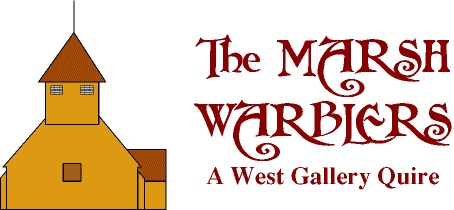
| 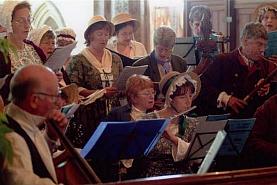
| 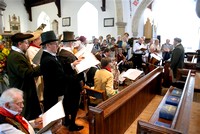
| 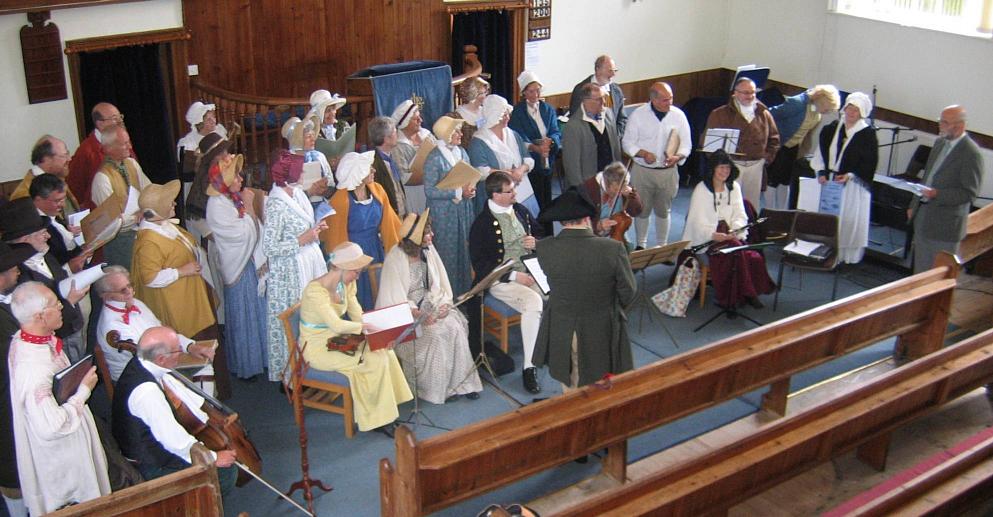
| 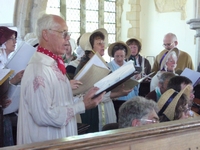 |
Home Page : Contact : Diary of Events : West Gallery Music : Composers : Recordings : Pictures : Research : Links | ||||

| 
| 
| 
|  |
Home Page : Contact : Diary of Events : West Gallery Music : Composers : Recordings : Pictures : Research : Links | ||||
|
In Search of Music Music Books - Printed and manuscript
Survival Music books, passed down in families, have occasionally turned up in charity shops and on eBay, although many more are still hidden away as family heirlooms, or maybe just forgotten in a cupboard or attic. Manuscript books from non-Conformist Chapels have so far come to light from Bethersden and Smarden. If you have an old music book, printed or hand-written, please contact us - a digital camera can capture the images without damaging the books and the music can be brought to life again by the Marsh Warblers. Over the Georgian period, there have been many changes in the way music was laid out in print. The music was mostly printed in open score, ie with one stave per part, either instrumental or vocal, and with the melody or air next above the bass, to facilitate keyboard accompaniment for domestic use or where there was an organ. Until about 1800, music for country choirs was printed with the air in the tenor (usually SATB), afterwards in the treble (or soprano) ie TASB, although some publications favoured ATSB. The alto and, less often, the tenor clefs were sometimes used until the end of the eighteenth century and the alto line was set an octave above sung pitch, so that it looks incredibly high (see picture below). Manuscript sources can be more problematical as they may have been copied inaccurately or have a reduced number of parts. Providing a melody can be identified, it can be coded and if it has been in print, its source can be identified using Professor Nicholas Temperley's online Hymn Tune Index. However, it often happens that many tunes found in manuscript sources cannot be identified with a printed source, often because they have been composed by local amateurs and never published. Some are of little musical merit but often an excellent arrangement can be discovered.

Evidence for West Gallery Choirs Diaries/Literary refs Stephen Rouse, the parish clerk of Minster on the Isle of Sheppey kept a diary for about forty years, recording all aspects of his life, his work, his family, and his involvement with the church, including attending choir rehearsals ("singing psalms") and copying out tunes for other choir members. John Byng, later the Fifth Viscount Torrington, travelled extensively in England and recorded details of his journeys. He visited many churches and was interested in the standard of music he found and often made enquiries of the parish clerk regarding the music. You can read an article about his comments on church matters HERE Singers' Agreements Before a choir was formed, some money had to be made available to buy music books or pay someone to teach or lead the members. Sometimes a decision was made by the Vestry, the principle ratepayers, to find the money, or a subscription was raised and parishioners contributed. Details of such a subscription has survived in the Hawkhurst parish chest: "March 10th 1784 - To the Inhabitants of the parish of HawkhurstThe names of 19 subscribers follow with their subscriptions totalling £1 13s 0d When a choir was formed, a set of rules was sometimes drawn up regarding attendance at rehearsals and services, small fines being imposed for absence. Kenardington, on the edge of Romney Marsh, was one such parish which formed a choir in 1773. "1773 Oct. 28th Ann agreement made for the Company of Psalm singers in Kenardington. We Do gree to forfitt two pence on all Sundays for not being at Church in Divine Sarvis time to joyn to sing to the praise an glory of GOD and to meet on Sunday Evening at Six o'clock and forfitt one penny and to meet on all Thursday evenings at Six o'clock or forfitt one penny for each Neglect of not being there at the time. The mony to be gathered by One Whom the Company apoint for that purpus and the forfitt mony to be Spent on January 1st 1774 at a place apointed by the Company. Agreed and aproved of by us Who have hear unto Sett our Names."The members signed their names (or made their mark). You can read a short article about this and a similar agreement HERE
Subscription lists in printed music collections: Composers often sought subscriptions in advance of their first publication to help towards the printing costs, eg Henry Tolhurst's "Six Anthems & Six Psalms" was subscribed to by choirs from Ightham (4 books), Stroud (2), Wateringbury (2), Hollingbourn (2), East Sutton (2), East Farleigh (1), and Sutton Valence (1) "The Society of Singers" at Zion Chapel, Margate subscribed to 4 copies of Thomas Clark's (First) Set of Psalm & Hymn Tunes "The Select Company of Singers" at Minster in Sheppey subscribed for 4 copies of John Barwick's Kentish Divine Harmony and 6 copies were purchased by the churchwardens of Whitstable parish church; in fact 31 copies were purchased by residents of Whitstable in total.

Singing Masters "Now was the long expected time arrived, when the psalms of King David should be hymned unto the same tunes to which he played them upon his harp; (so I was informed by my singing-master, a man right cunning in psalmody). Now was our over-abundant quaver and trilling done away, and in lieu thereof was instituted the sol-fa, in such guise as is sung in his majesty's chapel. I was ordained to adjoin myself unto them, though an unworthy disciple, in order to instruct my fellow-parishioners in this new manner of worship. I tutored the young men and maidens to tune their voice as it were a psaltery; and the church on the Sunday was filled with these new hallelujahs." Men with musical ability travelled around their area training village choirs and were paid from church funds. Sometimes they were also named in subscription lists, although those in the larger towns and cities mostly taught music lessons to private pupils. Singing masters (or 'teachers of psalmody') may also have been amateur composers and taken the opportunity of teaching some of their own arrangements to the choirs they instructed. Singing masters identified so far (more information about these men would be greatly appreciated): 
Unpublished Composers Many West Gallery composers were amateurs, often self-taught, and they mostly carried on a day job, even those more widely known through their published music, such as Thomas Clark, John Barwick or Henry Tolhurst. They were never figures of national importance, although thousands sang their music. However, it is interesting to find out more about their lives, their social background and their place in their communities. In an age when a musical education was only for the well to do, many people with musical ability, from humble backgrounds, found an outlet playing or singing in the church choir or in the pub. Some choir members even turned their hand to composing and their arrangements may have been copied into books used by church choirs in parishes many miles away.
There are many more settings of psalms, hymns and anthems which have been found in manuscript books which cannot be traced to printed sources so there's probably a good number of other amateur composers out there waiting to be identified. If you have any enquiries, comments or information you wish to share, please contact Tony Singleton |